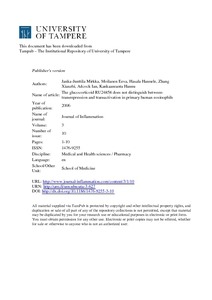The glucocorticoid RU24858 does not distinguish between transrepression and transactivation in primary human eosinophils
Janka-Junttila, Mirkka; Moilanen, Eeva; Hasala, Hannele; Zhang, Xianzhi; Adcock, Ian; Kankaanranta, Hannu (2006)
Janka-Junttila, Mirkka
Moilanen, Eeva
Hasala, Hannele
Zhang, Xianzhi
Adcock, Ian
Kankaanranta, Hannu
2006
Journal of Inflammation 3
10
This publication is copyrighted. You may download, display and print it for Your own personal use. Commercial use is prohibited.
Julkaisun pysyvä osoite on
https://urn.fi/urn:nbn:uta-3-627
https://urn.fi/urn:nbn:uta-3-627
Kuvaus
BioMed Central Open access
Tiivistelmä
Background
Glucocorticoids are used to treat chronic inflammatory diseases such as asthma. Induction of eosinophil apoptosis is considered to be one of the main mechanisms behind the anti-asthmatic effect of glucocorticoids. Glucocorticoid binding to its receptor (GR) can have a dual effect on gene transcription. Activated GR can activate transcription (transactivation), or by interacting with other transcription factors such as NF-κB suppress transcription (transrepression). RU24858 has been reported to transrepress but to have little or no transactivation capability in other cell types. The dissociated properties of RU24858 have not been previously studied in non-malignant human cells. As the eosinophils have a very short lifetime and many of the modern molecular biological methods cannot be used, a "dissociated steroid" would be a valuable tool to evaluate the mechanism of action of glucocorticoids in human eosinophils. The aim of this study was to elucidate the ability of RU24858 to activate and repress gene expression in human eosinophils in order to see whether it is a dissociated steroid in human eosinophils.
Methods
Human peripheral blood eosinophils were isolated under sterile conditions and cultured in the presence and/or absence RU24858. For comparison, dexamethasone and mometasone were used. We measured chemokine receptor-4 (CXCR4) and Annexin 1 expression by flow cytometry and cytokine production by ELISA. Apoptosis was measured by DNA fragmentation and confirmed by morphological analysis.
Results
RU24858 (1 μM) increased CXCR4 and Annexin 1 expression on eosinophils to a similar extent as mometasone (1 μM) and dexamethasone (1 μM). Like dexamethasone and mometasone, RU24858 did suppress IL-8 and MCP-1 production in eosinophils. RU24858 also increased spontaneous eosinophil apoptosis to a similar degree as dexamethasone and mometasone, but unlike dexamethasone and mometasone it did not reverse IL-5- or GM-CSF-induced eosinophil survival.
Conclusion
Our results suggest that in human eosinophils RU24858 acts as transactivator and transrepressor like classical glucocorticoids. Thus, RU24858 seems not to be a "dissociated steroid" in primary human eosinophils in contrast to that reported in animal cells. In addition, functionally RU24858 seems to be a less potent glucocorticoid as it did not reverse IL-5- and GM-CSF-afforded eosinophil survival similarly to dexamethasone and mometasone.
Glucocorticoids are used to treat chronic inflammatory diseases such as asthma. Induction of eosinophil apoptosis is considered to be one of the main mechanisms behind the anti-asthmatic effect of glucocorticoids. Glucocorticoid binding to its receptor (GR) can have a dual effect on gene transcription. Activated GR can activate transcription (transactivation), or by interacting with other transcription factors such as NF-κB suppress transcription (transrepression). RU24858 has been reported to transrepress but to have little or no transactivation capability in other cell types. The dissociated properties of RU24858 have not been previously studied in non-malignant human cells. As the eosinophils have a very short lifetime and many of the modern molecular biological methods cannot be used, a "dissociated steroid" would be a valuable tool to evaluate the mechanism of action of glucocorticoids in human eosinophils. The aim of this study was to elucidate the ability of RU24858 to activate and repress gene expression in human eosinophils in order to see whether it is a dissociated steroid in human eosinophils.
Methods
Human peripheral blood eosinophils were isolated under sterile conditions and cultured in the presence and/or absence RU24858. For comparison, dexamethasone and mometasone were used. We measured chemokine receptor-4 (CXCR4) and Annexin 1 expression by flow cytometry and cytokine production by ELISA. Apoptosis was measured by DNA fragmentation and confirmed by morphological analysis.
Results
RU24858 (1 μM) increased CXCR4 and Annexin 1 expression on eosinophils to a similar extent as mometasone (1 μM) and dexamethasone (1 μM). Like dexamethasone and mometasone, RU24858 did suppress IL-8 and MCP-1 production in eosinophils. RU24858 also increased spontaneous eosinophil apoptosis to a similar degree as dexamethasone and mometasone, but unlike dexamethasone and mometasone it did not reverse IL-5- or GM-CSF-induced eosinophil survival.
Conclusion
Our results suggest that in human eosinophils RU24858 acts as transactivator and transrepressor like classical glucocorticoids. Thus, RU24858 seems not to be a "dissociated steroid" in primary human eosinophils in contrast to that reported in animal cells. In addition, functionally RU24858 seems to be a less potent glucocorticoid as it did not reverse IL-5- and GM-CSF-afforded eosinophil survival similarly to dexamethasone and mometasone.
Kokoelmat
- Artikkelit [6140]
